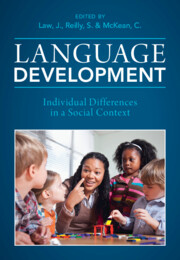Book contents
- Language Development
- Language Development
- Copyright page
- Contents
- Figures
- Tables
- Contributors
- A Tribute to Our Friend, Colleague and Fellow Editor, Professor James Law
- Introduction
- Part One Factors Influencing Language Development
- Part Two Continuity and Change
- Part Three Impact, Intervention and Equity
- 15 Communication, Participation and Cohort Studies
- 16 Capturing the Voice of Parents and Children
- 17 Oral Language Skills as a Foundation for Learning to Learn
- 18 The Economic Impact of Low Language Ability in Childhood
- 19 A Review of Interventions to Promote Language Development in Early Childhood
- 20 Interventions to Promote Language Development in Typical and Atypical Populations
- 21 The Effect of Kindergarten Instructional Policies on Reading and Math Achievement Gaps
- 22 Educational Interventions Targeting Language Development
- 23 Equity and Access to Services for Children with Language Difficulties
- Index
- References
16 - Capturing the Voice of Parents and Children
The Potential Impact for the Design and Implementation of Research and Services
from Part Three - Impact, Intervention and Equity
Published online by Cambridge University Press: 11 August 2022
- Language Development
- Language Development
- Copyright page
- Contents
- Figures
- Tables
- Contributors
- A Tribute to Our Friend, Colleague and Fellow Editor, Professor James Law
- Introduction
- Part One Factors Influencing Language Development
- Part Two Continuity and Change
- Part Three Impact, Intervention and Equity
- 15 Communication, Participation and Cohort Studies
- 16 Capturing the Voice of Parents and Children
- 17 Oral Language Skills as a Foundation for Learning to Learn
- 18 The Economic Impact of Low Language Ability in Childhood
- 19 A Review of Interventions to Promote Language Development in Early Childhood
- 20 Interventions to Promote Language Development in Typical and Atypical Populations
- 21 The Effect of Kindergarten Instructional Policies on Reading and Math Achievement Gaps
- 22 Educational Interventions Targeting Language Development
- 23 Equity and Access to Services for Children with Language Difficulties
- Index
- References
Summary
Research agendas in health and education are largely driven by professionals, resulting in a bias against the concerns of the participants in or receivers of the research. There is growing evidence of the positive influence of public and patient involvement (PPI) in research and within the field of language development and disorders, and there is increasing involvement of parents and children in research design and implementation. In this chapter, we discuss the importance of involving parents and children with language disorders in research and the facilitators and barriers to their involvement. The views of parents and children can redress bias in our research and provide balance to our evidence base. We argue that the voices of parents and children can inform our understanding of the social dimension of language development and disorder and shape the development of outcome measures that are valued and meaningful to children and their families. We also reflect on the contradictions in the professional discourse that reflect attitudes towards parents and children. We end with a consideration of how listening to parents and children might inform the study of language development and language disorder in large cohort studies and in the development and evaluation of interventions.
Keywords
- Type
- Chapter
- Information
- Language DevelopmentIndividual Differences in a Social Context, pp. 376 - 396Publisher: Cambridge University PressPrint publication year: 2022
References
- 2
- Cited by

